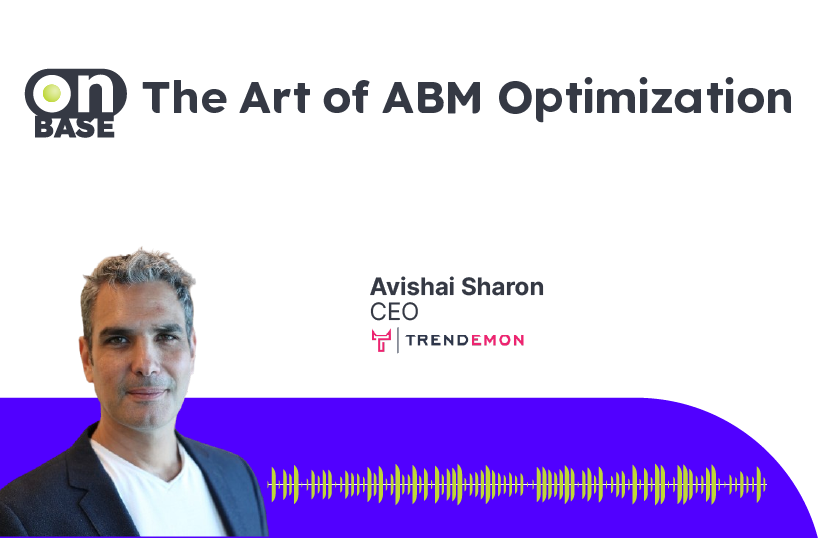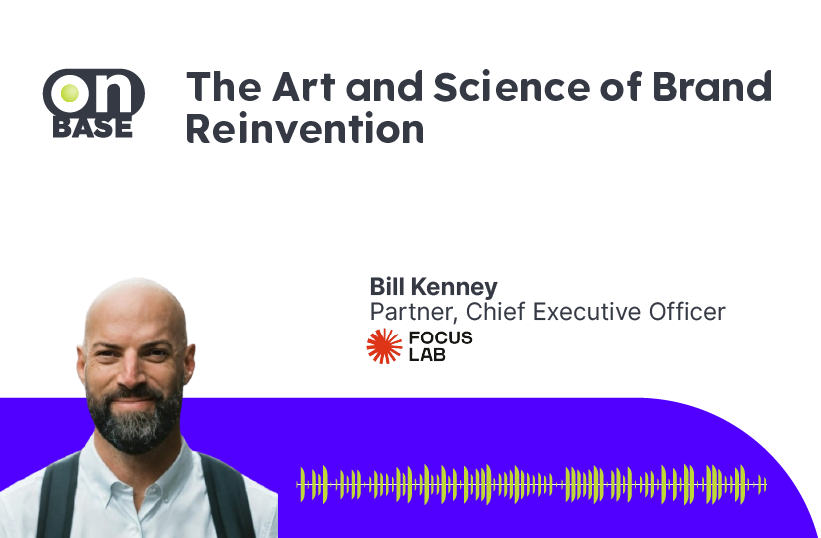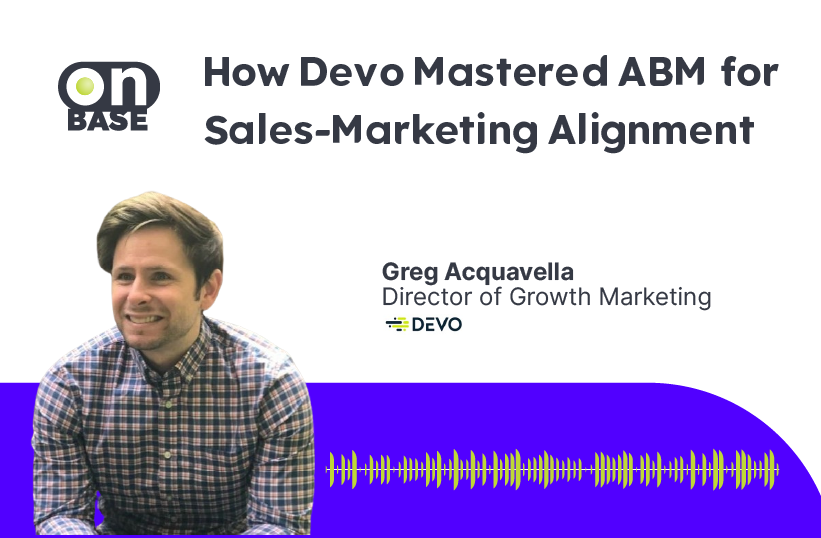Shownotes
In this episode, Avishai Sharon, Co-founder and CEO of TrenDemon, discusses the evolving landscape of B2B marketing and the rise of account-based strategies as a solution to the challenges posed by traditional demand generation tactics. He shares data-driven insights on the changing buyer journey, highlighting decreases in buying group size and website engagement, but increases in conversion rates and marketing investment. Avishai emphasizes the critical role of storytelling and audience captivation in supporting the buyer’s process, rather than solely focusing on lead capture. He provides recommendations for better alignment between marketing and sales teams around target accounts and the use of listening technologies and AI to optimize account-based efforts. Avishai predicts that ABM’s future evolution will center on understanding anonymous buying groups and orchestrating seamless journeys across multiple channels.
Best Moments
-
Avishai discusses the problem with traditional demand generation tactics and how ABM has become the solution to address the changing buyer environment.
-
Avishai shares insightful data from TrenDemon on the changing composition of the buying group, with a 35% decrease in the number of people and sessions from 2023 to 2024.
-
Avishai emphasizes the importance of storytelling and captivating audiences as a fundamental KPI for demand generation, moving beyond just lead capture.
-
Avishai highlights the evolving role of sales teams, focusing on listening capabilities and providing value as trusted advisors to support the buyer journey.
-
Avishai provides recommendations on the tools and technologies required to implement an effective account-based approach, including listening technologies and AI.
-
Avishai predicts the future evolution of ABM will focus on understanding the anonymous buying group and orchestrating journeys across multiple channels.
About the guest
Avishai Sharon, Co-founder and CEO of Trendemon, is a passionate entrepreneur with 20 years of experience in the marketing and sales technology landscapes and their transformative potential. Prior to leading Trendemon, a company revolutionizing the way B2B marketers can effortlessly optimize website experiences and orchestrate buyer journeys, Avishai founded GISight, a leading software development agency serving Fortune 500 customers. He developed his leadership skills during his tenure as an officer in the Israeli Air Force, serving in various key technological roles.
Key takeaways
- Traditional demand generation tactics are becoming increasingly ineffective, leading to the rise of account-based marketing (ABM) as a solution.
- Buyer behavior has shifted, with buyers remaining more anonymous and having greater control over their journey. This has resulted in low conversion rates from MQLs to pipeline.
- Data analysis by TrenDemon reveals decreases in buying group size and website engagement but increases in conversion rates and marketing investment, indicating a potential shift from the bear economy.
- Storytelling and consistently captivating audiences are critical for demand generation, moving beyond just lead capture. This requires educating leadership on the new marketing landscape.
- Sales teams need to focus on listening and providing value to support the buyer journey, with the gap between good and poor sales performance widening.
- Alignment between marketing and sales around target accounts is essential, with a shared understanding of the buying group and the inputs required to qualify and vet accounts.
- Leveraging listening technologies and AI can help uncover insights, personalize content, and orchestrate buying group journeys across multiple channels, which is a key focus for the future evolution of ABM.
Quotes
“If we are doing our job correctly, we are saving our buyers time. And I think this should be probably the main benefit, or the main advantage, or the objective of any go to market organization.” -Avishai Sharon
Highlights from this episode
What would you say to folks who think about ABM as just another tactic or channel, to set the stage for what you’re working to solve?
In his response, Avishai Sharon explains that traditional demand generation and lead capture tactics are no longer effective in the current B2B marketing landscape. Buyers have gained more power and control, often remaining anonymous throughout their journey.
This shift in buyer behavior has completely upended the traditional process of capturing leads and then nurturing them with more information. Avishai states that this frustration with ineffective marketing approaches is a big part of the problem that companies are facing.
He positions account-based marketing (ABM) as the solution to address this changing buyer environment. ABM is not just another tactic or channel, but a fundamental shift in how companies need to approach their go-to-market strategies to effectively support the modern buyer’s journey.
Avishai emphasizes that ABM has become the answer to the challenges posed by the new buyer dynamics, where traditional tactics are no longer working. This sets the stage for him to dive deeper into the insights and strategies around optimizing account-based approaches.
What are some of the insights that you see are most effective for optimizing account based strategies?
Avishai Sharon provided the following key insights:
- Understanding the Buying Group: Avishai emphasizes that understanding the composition of the buying group is fundamental to supporting the buyer journey. He shares data showing a decrease in the average buying group size from 13 people in 2023 to 9 people in 2024, along with a decrease in the number of website sessions and pages read.
- Diminishing Attention: Avishai notes that the buying group has less attention, with fewer sessions and pages read. This highlights the challenge of capturing and maintaining the attention of the diverse buying group.
- Conversion Rate Improvements: Despite the decreases in buying group size and engagement, Avishai shares a positive trend – a 15% increase in the conversion rate of inbound accounts to pipeline, from 1.3% in 2023 to 1.5-1.6% in the first half of 2024.
- Increased Marketing Investment: Avishai also points to a 120% increase in paid media investment and a 60% growth in organic traffic, indicating a potential shift towards a more positive economic outlook and a willingness to invest in growth.
These insights provide a data-driven understanding of the evolving buyer behavior and the opportunities for optimizing account-based strategies to effectively engage and convert target accounts.
How do you think about storytelling and the role that it should play in demand generation to enhance the audience engagement?
Avishai emphasizes that as the traditional demand generation tactics become less effective, the game today is about captivating audiences. He explains that as humans, we are captivated by stories, as we care about being successful in our roles and seek value that can help us achieve that.
Avishai states that storytelling, in the broader sense of creating content that provides value, is now a fundamental piece of go-to-market strategy. It’s not just about generating traffic or fulfilling “touchy-feely, fluffy top of funnel objectives” – it is demand generation at its core.
He highlights the need to educate leadership on this new environment, where the ability to tell a compelling story to the audience, even if they are not ready to buy, is critical. This is because only 5% of the audience is actively in the market, while the remaining 95% are the most relevant, as they are the ones that competitors may have already built relationships with.
Avishai emphasizes that storytelling and captivating audiences should be a fundamental KPI for companies, as it is not enough to just focus on influencing leads or pipeline. Measuring the ability to captivate and engage the audience in a recurring way is crucial, and this needs to be translated into economic terms that the leadership can understand.
Overall, Avishai advocates for a shift in mindset, where storytelling and audience engagement are seen as core demand generation strategies, rather than just “fluffy” brand-building exercises.
What recommendations or advice do you have for marketing and sales teams to better align around account based effectiveness?
Here are the key recommendations and advice Avishai has for marketing and sales teams to better align around account-based effectiveness:
- Start with the Target Audience: Avishai emphasizes that the alignment should begin with a shared understanding of the target audience – who are the ideal customers, why are they the ideal, and what inputs and signals can both marketing and sales use to qualify and vet these accounts.
- Surround the Accounts: Avishai suggests that the revenue organization as a whole should work to surround the target accounts, with coordinated efforts from field marketing, digital, sales, customer success, partners, and channels. The goal is to make the target accounts feel that they are the ideal customer for the company.
- Continuous Communication: Avishai stresses the importance of continuous communication between marketing and sales to discuss the target accounts, the journey they are on, and the support each team can provide to streamline that journey.
- Customer-Centric Approach: He emphasizes the need for a customer-centric approach, not just when the customer is acquired, but also before they become a customer. The goal is to make the target accounts feel understood and supported throughout their journey.
- Shared Metrics and KPIs: Avishai recommends aligning on shared metrics and KPIs, such as the number of engaged accounts and intentful accounts, which can be tied to closing rates and presented to leadership.
The key is to have marketing and sales teams work together from the very beginning, with a shared understanding of the target audience and a coordinated effort to support the buyer’s journey, rather than operating in silos.
What are the tools and technologies that you feel are required to start to implement this account based approach?
Here are the key tools and technologies Avishai recommends for implementing an effective account-based approach:
- Gap Analysis Tools: Avishai suggests starting with tools that help companies understand the gaps in their go-to-market process. This allows them to address any issues with messaging, positioning, or awareness before rushing into execution.
- Demand Intelligence Platforms: Tools like Demandbase can help companies understand if their target accounts are even aware of them and visiting their website. This foundational first-party data is crucial.
- Listening Technologies: Avishai emphasizes that listening technologies are game-changers in the current B2B landscape. The more a company can listen to the signals and interactions happening on their website and outside, the better they can operationalize that information and gain an advantage over the competition.
- AI-Powered Insights: Avishai discusses how AI can help ingest large amounts of data, summarize content consumption by accounts, and automatically score intent levels. This allows sales teams to quickly understand what’s resonating and personalize their outreach.
- Personalization and Content Optimization: Building on the AI-powered insights, Avishai highlights the ability of these technologies to help determine the best next piece of content to present to a specific account, enhancing personalization and relevance.
The key is to start with tools that provide visibility and understanding, then leverage listening and AI capabilities to capture signals, operationalize insights, and deliver more personalized, relevant experiences to target accounts.
What emerging trends will have the biggest impact in the next five years?
According to Avishai Sharon, the emerging trend that he believes will have the biggest impact on the industry in the next five years is the evolution of account-based marketing (ABM) to focus more on understanding the buying group in an anonymous world. Specifically, Avishai predicts that the future of ABM will shift towards:
- Understanding the Buying Group: Avishai emphasizes that as buyers remain more anonymous, the focus of ABM will need to move towards understanding the different people, personas, roles, and responsibilities within the buying group.
- Addressing Anonymity: He notes that the challenge will be to uncover insights about the buying group without relying on the buyers to de-anonymize themselves, as that is unlikely to happen.
- Leveraging AI: Avishai believes that AI will be a critical enabler in this evolution, as it can help uncover signals and insights about the buying group without the need for direct identification.
- Orchestrating Cross-Channel Journeys: Another key focus area will be the ability to orchestrate seamless buying group journeys across multiple channels, as the diversity and anonymity of the group makes this a significant challenge.
Avishai sees this shift towards a deeper understanding of the anonymous buying group as a crucial area of development for ABM in the next five years, enabled by advancements in AI and other listening technologies.
Resource recommendations
Podcasts:
- NexGen CMO with Kelly Hopping
- Nick Bennett’s People-First GTM Model on Marketing Powerups podcast
Shout-outs
- Jon Miller, MarTech entrepreneur and Former CMO, Demandbase
- Kelly Hopping, CMO, Demandbase
- Nick Bennett, Chief Customer Officer & Co-Founder, Tack

OnBase
Bridging the Divide, Between Sales and Marketing




